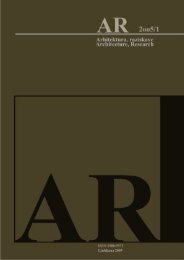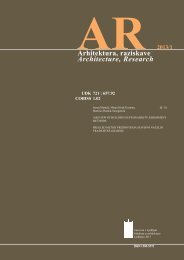2oo2/1 - Fakulteta za arhitekturo - Univerza v Ljubljani
2oo2/1 - Fakulteta za arhitekturo - Univerza v Ljubljani
2oo2/1 - Fakulteta za arhitekturo - Univerza v Ljubljani
You also want an ePaper? Increase the reach of your titles
YUMPU automatically turns print PDFs into web optimized ePapers that Google loves.
Vladimir Bre<strong>za</strong>r<br />
THE VICIOUS CIRCLE OF DEVELOPMENT IN HOUSING<br />
short notice. It may be a consequence of big national projects<br />
(like the dwelling camp for builders of new Egyptian capital at<br />
Tel elAmarna), of intense migration from rural provinces in town<br />
(high-rise and dense Roman insulae) or just the need to<br />
concentrate people for practical reasons (labor colonies at the rise<br />
of industrial revolution).<br />
In modern times the overpopulation exceeded the critical mass<br />
and the demand for shelter can never again be met all around the<br />
world. In solving the problem all kind of measures and systems<br />
have been invented. Governments have stablished special<br />
housing policies and even ministries, research institutes,<br />
financing schemes and standards. Methods for mass housing<br />
production have been developed mostly based on industrialized<br />
systems. Modern technologies from other fields have been<br />
introduced in residential buildings - the most wide spread among<br />
them concrete. New types of buildings were made possible that<br />
way (high-rise blocks) and also new types of settlements have<br />
appeared as the result (housing estates, sattelite towns).<br />
Modern democracies have brought forward a costitutional right<br />
to get shelter (socialism) or to have equal opportunities to get one<br />
(capitalism). Both resulted in the philosophy of equal needs<br />
("equal stomachs") and consequently in standard dwelling size,<br />
layout and fittings and utterly uniform living environment at the<br />
end.<br />
Figure 3: Fire regulations shape townscape<br />
TECHNOLOGY<br />
Primeaval shelter has been built of local natural materials (wood,<br />
clay, stone, hide, straw) and in self -help manner. Invention of<br />
tools made it possible to use more durable and sophisticated<br />
materials: stone cut to purpose, larger timber sections<br />
appropriately shaped for joining, brick moulded in universally<br />
applicable pieces.<br />
10<br />
The difference in meaning between domestic, practical housing<br />
construction and building for public use, for the ruling elite or<br />
god has always been expressed in the choice of materials.<br />
Dwellings have been built of lesser, cheaper and not so durable<br />
materials. Ancient Egyptian court house we know only indirectly<br />
- assuming that monumental palaces have been the same thing in<br />
bigger scale and that todays housing in Nile valley is still an echo<br />
of the tradition. If not for Pompei we would know much less about<br />
Roman dwelling culture. Even today the mass housing in<br />
underdeveloped countries is being constructed of cheap if not<br />
inadequate materials.<br />
Only organized mass housing production has changed this<br />
general rule. The use of concrete in 20th century made it possible<br />
to construct high-rise and extremely dense living environment. It<br />
has several advantages: efficient (industrial) production methods,<br />
high structural performances and safety. It is also durable more<br />
than any building material until now - it will sustain for a long<br />
time and its destruction will be expensive. The concrete structures<br />
are very difficult to adapt so they are due to become obsolete. In<br />
most urban agglomerations all over the world this "concrete<br />
heritage" has become a burden, a social and economic problem.<br />
Although in some regions and countries other materials are being<br />
used in mass housing production (mostly brick and wood) the use<br />
of concrete can simply not be avoided any more, especially in<br />
earthquake areas.<br />
The modern trends in architecture are focused on the nonpermanent<br />
philosophy - even in public and monumental realm.As<br />
housing has always been under permanent pressure for changes,<br />
adaptations and accomodations to new needs of new generations<br />
it is obvious that modern housing architecture should adopt this<br />
attitude. Temporary building is at the end considered as the most<br />
sustainable one. It is no wonder that modern ecological and<br />
sustainable housing architecture turned "back" to the natural,<br />
renewable and reusable materials: brick, clay, wood and straw.<br />
The loop is closed again.<br />
CULTURE<br />
Housing is a part of broader term "material culture" as<br />
ethnologists call the special human activities involved in<br />
transforming environmental elements and objects to his own<br />
benefit. It is a complex system of tasks, relationship and<br />
behaviour that result in special sorts of material products, tools,<br />
works of art, clothes and buildings.<br />
Parallel to the increase of personal standard people become<br />
effeminate. They want to retreat to their own rooms, they need to<br />
be warmed or cooled excessively and they keep their dwellings as<br />
clean as possible.<br />
Human behaviour is one of the most interesting field to have<br />
direct impact on housing or more exactly on living pattern (often<br />
described as dwelling culture). It changes in time and place<br />
constantly.<br />
"Primitive" societies have strict social structure and strong rules<br />
to be obeyed regarding the attitude between privacy and public.<br />
One was not allowed to look into kings eyes but it is commonly<br />
known that king of France used to give audience sitting on the<br />
stool with chamber pot. Shame and the attitude to nudity have

















